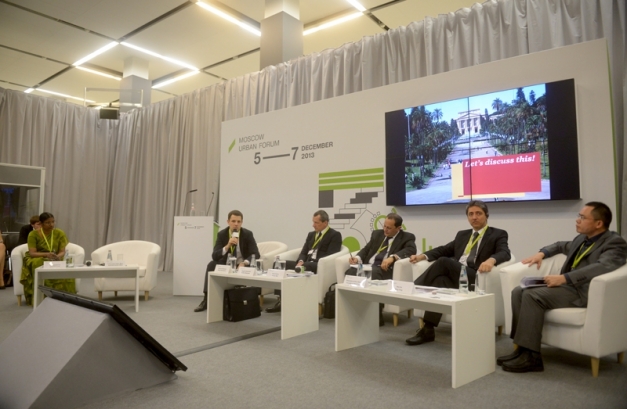From Moscow to Sao Paulo: The Results of PwC research

The key theme of the forthcoming session, “From Moscow to São Paulo: Similarities and Differences Between Cities in Rapidly Developing Countries,” is the PwC study prepared especially for Moscow Urban Forum as a part of the larger annual PwC research; that is, “Cities of Opportunities.” The experts focused both on common traits and differences between the biggest megacities of rapidly developing countries and ratios of their main development factors, as well as on prospective directions. The moderators for the session were the Advisor to the Mayor of Moscow, Rector of the SKOLKOVO Moscow School of Management Andrey Sharanov, and Hazem Galal of PwC (Qatar).
Big cities have become the driving economic force of the modern world. This is especially obvious when considering the leading countries with expanding market economies, such as Russia, Brazil, India, China, Mexico, Turkey, and Indonesia.
Moscow’s Place in the E7
The idea for such a study appeared within Moscow Urban Forum 2012. The choice of cities was determined by the fact that the global center of attraction is switching from the West to the East. The seven biggest cities — the cities of which the Emerging 7 Group consists (Moscow, São Paulo, Beijing, Mumbai, Mexico City, Istanbul, and Jakarta) — represent different climatic zones, and as such are the world’s most rapidly developing cities. They are examined using 60 variables and 10 indicator categories.
Andrey Sharanov recalled that Moscow Urban Forum had arisen as a discussion platform for developing urban centers. The exchange of opinions and experience within the boundaries of such an event help provide a view of the direction the cities can take in their development and understand their strong and weak points to boot.
PwC research compared the cities according to the following indicators: intellectual capital and innovations, technology readiness level, health development, transport infrastructure, environmental issues, demographic rate, economic influence, ease of doing business, and cost of living. Moscow takes second place in the general rating among E7 cities, superseded only by Beijing, but in some categories — level of education, for example — Moscow is ahead of other cities. Moscow also takes second place pursuant to technological development, investment climate, and occupational level.
Future Insight
Hazem Galal mentioned that E7 cities had been examined not only from the vantage point of modern conditions, but also in terms of development and opportunities. The moderator asked all of the discussion participants to foresee the future and tell everyone how they saw their cities in 2025.
Fernando de Mello Franco, São Paulo’s Municipal Secretary for Urban Development, named São Paulo a primary magnet, the center of attraction for South America, and, at the same time, a bomb that simultaneously attracts and repels and is ready to explode from inside. The task of the city government is to turn this region into a macrocity uniting five urban settlements that are 100 km from each other.
The Chinese centers of attraction faced rather different tasks. Yang Ming, Chief Engineer of the Planning Research Department of the Beijing Municipal Institute of City Planning and Design (BICP), talked about the main problems that are to be tackled by the Beijing government. These included the development of transport and social infrastructure, as well as the housing problem. Yang Ming also mentioned that Beijing is an amalgamation of a 3000-year history and a modern infrastructure that had been greatly enhance by the Olympic construction activity.
Chief Architect of Moscow Sergey Kuznetsov named several degrees of Moscow’s identity. Thinking globally, the capital is a historic architectural heritage and the Metro is a “public church.” Moscow is also a trendsetter within the country that attracts people’s attention from other towns to the issues of public space and urban environment. Sergey Kuznetsov believes that Moscow should be a bright city, comfortable from the point of view of transport and communications, and also retain its cultural and scientific development. It is namely the efficient expanding economy of the agglomeration that should be the pivotal driving force in attracting residents to the city. “It is impossible for us to become a warmer city, but we can become more attractive and hospitable,” the Chief Architect concluded.
Become an Engine of Growth
All sides agreed that the big cities should develop together with their governed regions. Regional development plans need to be coordinated with the development plans of the main city. The most optimistic prospects reside with those cities that take care of their own stable development. This helps them to remain independent of fluctuations in the world economy and to open the potential of the periphery. As the speakers mentioned, the environmental situation was one of the biggest problems for all of the big cities. The parks and woods may be useful not only for the local population, but they also can attract tourists. Moreover, public space investments can increase capitalization of the territory.
Andrey Sharonov summarized the whole discussion, emphasizing that no study can be absolutely accurate, and there is always something to think about. “The most important thing is to see the current situation from different points of view,” concluded the Rector of the SKOLKOVO Moscow School of Management. Moscow is, in fact, in the same league as the world’s largest cities as a full-fledged participant in the exchange of international experience. Moscow has everything needed to become a driver of growth for the entire Russian economy and can help turn Russia into a major European economy by 2020.
This story originally appeared on Mosurbanforum.
- Tags:
- Mosurbanforum |
- Sergey Kuznetsov



